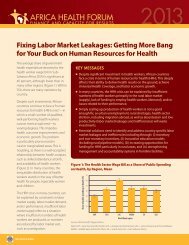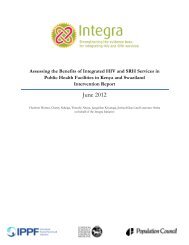ujh78
ujh78
ujh78
Create successful ePaper yourself
Turn your PDF publications into a flip-book with our unique Google optimized e-Paper software.
4.3 Lack of Access to Any Sanitation Facilities Whatsoever in or near Their<br />
Homes<br />
The aim of Millennium Development Goal 7 is to reduce by half the proportion of people without<br />
basic sanitation facilities by 2015 (WHO, 2009). It has been calculated that, to meet this goal, countries in<br />
sub-Saharan Africa would need to spend an estimated 0.9 percent of their gross domestic product (GDP)<br />
annually in the sector—0.5 percent for new infrastructure, 0.2 percent for rehabilitation of existing assets,<br />
and 0.2 percent for operation and maintenance (Morella et al., 2008).<br />
Lack of sanitation is a serious global health problem, affecting 2.5 billion people, particularly the<br />
poor and disadvantaged, who must defecate openly, a practice that places them at higher risk of disease<br />
transmission (UNICEF/WHO Joint Monitoring Program, 2012). About 10% of the total global disease<br />
burden is attributable to unsafe water, sanitation, and hygiene. Researchers have associated illnesses<br />
related to inadequate sanitation with about 3.6 million deaths each year (Pruss-Ustun et al., 2008).<br />
There was large variation in the percentage of children without access to any sanitation facilities<br />
in sub-Saharan Africa (see Map 4.3). This percentage ranged from less than 3% in Burundi and Rwanda<br />
to 81% in Niger (see Table 4.4). Two of every three children in Burkina Faso, Chad, and Niger did not<br />
have access to any sanitation facilities in or near their homes. In Namibia and Liberia more than half of<br />
children under 18 years of age did not have access to any sanitation services.<br />
Sex and geographic disparities<br />
In general, there were no disparities related to children’s sex in their access to sanitation facilities<br />
(see Figure 4.13). Lack of sanitation facilities was more common for boys than girls by about two<br />
percentage points in Burkina Faso (males: 68% and females: 65%), Ghana (males: 27% and females:<br />
24%), and Liberia (males: 56% and females: 54%) (see Table 4.4).<br />
In all of these sub-Saharan African countries, rural children were more likely than urban children<br />
to lack access to any sanitation facilities (see Figure 4.14). This geographic disparity was most marked—<br />
at least 60 percentage points—in Burkina Faso (urban: 15% and rural: 79%), Chad (17% and 85%),<br />
Namibia (17% and 82%), and Niger (19% and 93%) (see Table 4.4).<br />
The role of the household head’s sex and age<br />
In four countries the percentage of children without access to any sanitation services was more<br />
than 11 percentage points higher for children living with a male household head than for children living<br />
with a female household head—Senegal (male household head: 21% and female household head: 10%),<br />
Burkina Faso (68% and 56%), Benin (69% and 57%), and Ghana (29% and 17%) (see Figure 4.15). In<br />
Namibia 76% percent of children living with a household head older than age 50 did not have access to<br />
any sanitation facilities, compared with 53% of those living with a younger head of household—a<br />
difference of 23 percentage points (see Figure 4.16 and Table 4.4).<br />
Variations during the last 13 years<br />
Ethiopia achieved the largest reduction (23 percentage points) in the percentage of children who<br />
do not have access to any sanitation facilities, from 66% in 2005 to 43% in 2011 (see Table 4.2). Other<br />
countries that experienced a reduction of more than 5 percentage points included Burkina Faso (2003:<br />
73% and 2010: 68%), Lesotho (2004: 51% and 2009: 41%), Malawi (2004: 16% and 2010: 11%), and<br />
Mozambique (2003: 50% and 2011: 43%) (see Figures 4.17 and 4.18). Only Nigeria (2003: 25% and<br />
2008: 31%) and Tanzania (2004-05: 17% and 2010: 19%) experienced increases in the percentage of<br />
children who did not have access to any sanitation facilities.<br />
62








